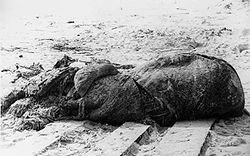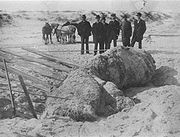
Globster
Encyclopedia

Organic matter
Organic matter is matter that has come from a once-living organism; is capable of decay, or the product of decay; or is composed of organic compounds...
that washes up on the shoreline of an ocean or other body of water. The term was coined by Ivan T. Sanderson
Ivan T. Sanderson
Ivan Terence Sanderson was a naturalist and writer born in Edinburgh, Scotland, who became a naturalized citizen of the United States. Sanderson is remembered for his nature writing and his interest in cryptozoology and paranormal subjects.-Biography:Born in Scotland, Sanderson traveled widely in...
in 1962 to describe the Tasmanian carcass of 1960
Tasmanian Globster
The Tasmanian Globster was a large unidentified carcass that washed ashore in western Tasmania, in August 1960. It measured by and was estimated to weigh between 5 and 10 tons. The mass lacked eyes and in place of a mouth, had "soft, tusk-like protuberances"...
, which was said to have "no visible eyes, no defined head, and no apparent bone structure". A globster is distinguished from a normal beached carcass by being hard to identify, at least by initial untrained observers, and by creating controversy as to its identity.
Globsters may present such a puzzling appearance that their nature remains controversial even after being officially identified by scientists. Some globsters lack bone
Bone
Bones are rigid organs that constitute part of the endoskeleton of vertebrates. They support, and protect the various organs of the body, produce red and white blood cells and store minerals. Bone tissue is a type of dense connective tissue...
s or other recognisable structures, while others may have bones, tentacle
Tentacle
A tentacle or bothrium is one of usually two or more elongated flexible organs present in animals, especially invertebrates. The term may also refer to the hairs of the leaves of some insectivorous plants. Usually, tentacles are used for feeding, feeling and grasping. Anatomically, they work like...
s, flipper
Flipper (anatomy)
A flipper is a typically flat limb evolved for movement through water. Various creatures have evolved flippers, for example penguins , cetaceans A flipper is a typically flat limb evolved for movement through water. Various creatures have evolved flippers, for example penguins (also called...
s, eyes or other features that can help narrow down the possible species. In the past these were often described as sea monsters
Sea Monsters
Sea Monsters was a BBC television trilogy which used computer-generated imagery to show past life in Earth's seas. In the U.S. it was known as Chased by Sea Monsters. It was made by Impossible Pictures, the creators of Walking with Dinosaurs, Walking with Beasts and Walking with Monsters...
, and myths and legends about such monsters may often have started with the appearance of a globster. Globsters are most frequently studied in the field of cryptozoology
Cryptozoology
Cryptozoology refers to the search for animals whose existence has not been proven...
.
Many globsters have initially been described as gigantic octopus
Gigantic octopus
An unknown species of gigantic octopus has been hypothesised as a source of reports of sea monsters such as the lusca and the kraken as well as the source of some of the carcasses of unidentified origin known as globsters like the St. Augustine Monster. The species that the St...
es, although they later turned out to be the decayed carcasses of whale
Whale
Whale is the common name for various marine mammals of the order Cetacea. The term whale sometimes refers to all cetaceans, but more often it excludes dolphins and porpoises, which belong to suborder Odontoceti . This suborder also includes the sperm whale, killer whale, pilot whale, and beluga...
s or large shark
Shark
Sharks are a type of fish with a full cartilaginous skeleton and a highly streamlined body. The earliest known sharks date from more than 420 million years ago....
s. As with the "Chilean Blob
Chilean blob
The Chilean Blob was a 13-tonne mass of tissue discovered on Pinuno Beach in Los Muermos, Chile in July 2003. It made headlines around the world because biologists were unable to identify it, and were speculating that it was the remains of some species of giant octopus previously unknown to...
" of 2003, many are masses of whale blubber
Blubber
Blubber is a thick layer of vascularized adipose tissue found under the skin of all cetaceans, pinnipeds and sirenians.-Description:Lipid-rich, collagen fiber–laced blubber comprises the hypodermis and covers the whole body, except for parts of the appendages, strongly attached to the musculature...
released from decaying whale corpses. Others initially thought to be dead plesiosaur
Plesiosaur
Plesiosauroidea is an extinct clade of carnivorous plesiosaur marine reptiles. Plesiosauroids, are known from the Jurassic and Cretaceous Periods...
s later turned out to be the decayed carcases of basking shark
Basking shark
The basking shark is the second largest living fish, after the whale shark. It is a cosmopolitan migratory species, found in all the world's temperate oceans. It is a slow moving and generally harmless filter feeder and has anatomical adaptations to filter feeding, such as a greatly enlarged...
s. Others remain unexplained. Giant
Giant squid
The giant squid is a deep-ocean dwelling squid in the family Architeuthidae, represented by as many as eight species...
and colossal squid
Colossal Squid
The colossal squid , sometimes called the Antarctic or giant cranch squid, is believed to be the largest squid species in terms of mass. It is the only known member of the genus Mesonychoteuthis...
may also explain some globsters, particularly those tentatively identified as monster octopus
Octopus
The octopus is a cephalopod mollusc of the order Octopoda. Octopuses have two eyes and four pairs of arms, and like other cephalopods they are bilaterally symmetric. An octopus has a hard beak, with its mouth at the center point of the arms...
es.
Some globsters have been examined only after they had decomposed too much to be used as evidence for a new species, or have been destroyed, as happened with the famous "Cadborosaurus willsi
Cadborosaurus willsi
"Cadborosaurus willsi", nicknamed Caddy, is an alleged sea serpent reported to be living on the Pacific Coast of North America. Its name is derived from Cadboro Bay in Victoria, British Columbia, and the Greek root word "saurus" meaning lizard or reptile...
" carcass, found in 1937. However, Canadian scientists did in fact perform a DNA analysis of the Newfoundland Blob
Newfoundland Blob
The Newfoundland Blob was an unidentified mass that washed ashore near St. Bernard’s, Fortune Bay, Newfoundland on 2 August 2001. The specimen was 5.6 m long. Analysis of samples in 2002 showed that the Newfoundland Blob was a portion of the carcass of a sperm whale.-References:* Puig, R. 2004. ...
that indicated the tissue was from a sperm whale
Sperm Whale
The sperm whale, Physeter macrocephalus, is a marine mammal species, order Cetacea, a toothed whale having the largest brain of any animal. The name comes from the milky-white waxy substance, spermaceti, found in the animal's head. The sperm whale is the only living member of genus Physeter...
. In their resulting paper, the authors point out a number of superficial similarities between the Newfoundland Blob and other famous globsters, concluding a similar origin for those globsters is likely. Analyses of other globsters have yielded similar results.
Famous globsters


- unidentified carcass from Santa Maria del Mar, OaxacaOaxacaOaxaca , , officially Estado Libre y Soberano de Oaxaca is one of the 31 states which, along with the Federal District, comprise the 32 federative entities of Mexico. It is divided into 571 municipalities; of which 418 are governed by the system of customs and traditions...
, MexicoMexicoThe United Mexican States , commonly known as Mexico , is a federal constitutional republic in North America. It is bordered on the north by the United States; on the south and west by the Pacific Ocean; on the southeast by Guatemala, Belize, and the Caribbean Sea; and on the east by the Gulf of...
(1648) - Stronsay BeastStronsay BeastThe Stronsay beast was a large, dead carcass or globster that washed ashore on the island of Stronsay , in the Orkney Islands, after a storm on September 25, 1808...
(1808) - New River Inlet Carcass (1885)
- St. Augustine MonsterSt. Augustine MonsterThe St. Augustine Monster is the name given to a large unidentified carcass, originally postulated to be the remains of a gigantic octopus, that washed ashore on the United States coast near St. Augustine, Florida, in 1896. It is sometimes referred to as the Florida Monster or St. Augustine Giant...
(1896) - TrunkoTrunkoTrunko is the nickname for an animal or globster reportedly sighted in Margate, South Africa, on October 25, 1924, according to an article entitled "Fish Like A Polar Bear" published in the December 27, 1924, edition of London's Daily Mail. The animal was reputedly first seen off the coast battling...
(1924) - Dunk Island Carcass (1948)
- Gulf of Alaska Carcass (1956)
- Melbourne-Hobart Carcass (1958)
- Tasmanian GlobsterTasmanian GlobsterThe Tasmanian Globster was a large unidentified carcass that washed ashore in western Tasmania, in August 1960. It measured by and was estimated to weigh between 5 and 10 tons. The mass lacked eyes and in place of a mouth, had "soft, tusk-like protuberances"...
(1960) - Hamai Beast (1963)
- New Zealand GlobsterNew Zealand GlobsterThe New Zealand Globster was a large unidentified carcass that washed ashore at Muriwai, on the west coast of North Island, New Zealand, in 1968. It was long and high. J. E. Morton, chairman of the Zoology Department at the University of Auckland, was quoted as saying, "I can't think of anything...
(1968) - Tecoluta Carcass (1969)
- Tasmanian Globster 2 (1970)
- Mann Hill Beach Globster (1970)
- GamboGambo"Gambo" is the name given to a carcass of an unidentified large marine animal that was reportedly washed up on Bungalow Beach in The Gambia....
(1983) - Bermuda BlobBermuda BlobBermuda Blob is the name given to two globsters that washed ashore on Bermuda in 1988 and 1997. At first thought to be the remains of a cryptid, analysis suggests that the blobs were the remains of known sea creatures....
(1988) - Godthaab Globster (1989)
- Hebrides BlobHebrides BlobThe Hebrides blob was an unidentified, long carcass that washed ashore on Benbecula beach in the Hebrides, Scotland, in 1990. Louise Whitts, who discovered the carcass, described it as follows: "It had what appeared to be a head at one end, a curved back and seemed to be covered with eaten-away...
(1990) - North Carolina Globster (1996)
- Nantucket BlobNantucket BlobThe Nantucket Blob was an unidentified mass that washed ashore on Nantucket Island, Massachusetts, sometime during November 1996. Analysis of samples in 2004 suggests that the Nantucket Blob was a large mass of adipose tissue from a whale....
(1996) - Bermuda Blob 2 (1997)
- Four Mile GlobsterFour Mile GlobsterThe Four Mile Globster was an unidentified mass that washed ashore in Four Mile Beach, Tasmania, in 1997. The carcass was long, wide, and was estimated to weigh 4 tons. It was described as having paddle-shaped flippers, strands of white hair, and six fleshy lobes along its sides....
(1997) - Newfoundland BlobNewfoundland BlobThe Newfoundland Blob was an unidentified mass that washed ashore near St. Bernard’s, Fortune Bay, Newfoundland on 2 August 2001. The specimen was 5.6 m long. Analysis of samples in 2002 showed that the Newfoundland Blob was a portion of the carcass of a sperm whale.-References:* Puig, R. 2004. ...
(2001) - Chilean BlobChilean blobThe Chilean Blob was a 13-tonne mass of tissue discovered on Pinuno Beach in Los Muermos, Chile in July 2003. It made headlines around the world because biologists were unable to identify it, and were speculating that it was the remains of some species of giant octopus previously unknown to...
(2003)
Further reading
- Clark, Jerome and Coleman, Loren. (1999). Cryptozoology A-Z. Simon & Schuster.

